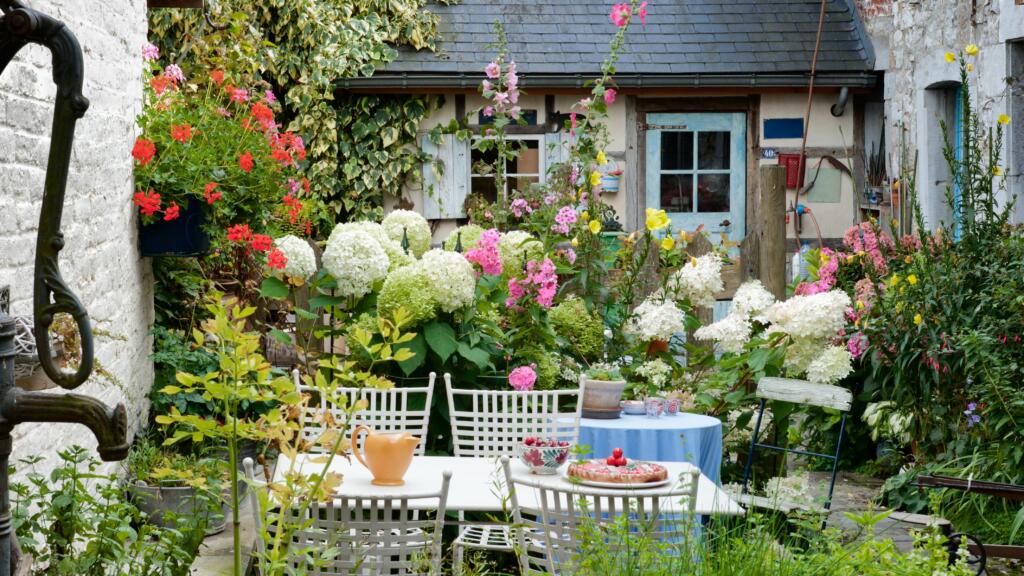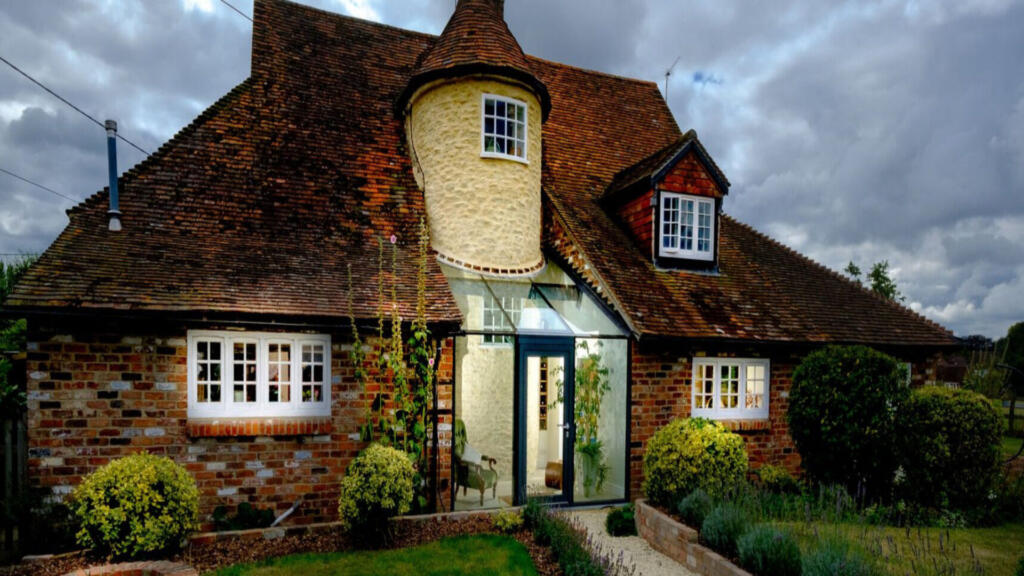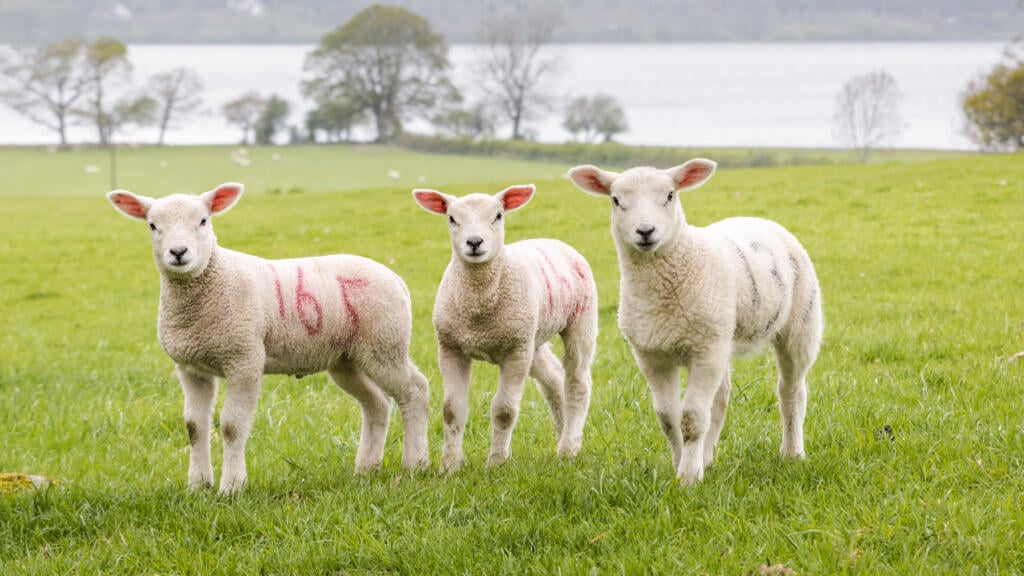
Best plants for a raised bed: 14 top flowers and shrubs to pick
Rosanna Spence
Why should a cosy garden restrict your wildest design dreams?
In his Channel 4 series Amazing Spaces George Clarke has shown us time and again that tiny spaces can make wonderful homes. Each design cleverly maximises every inch of space without sacrificing that indefinable feeling of home. The same approach can transform a small garden. It’ll reveal space you never knew you had, creating an outdoor ‘room’ where you can entertain, grow veg, cook, or just sit back and enjoy nature.
Apparently, the average UK garden size is 188 sq m (2023 sq ft), according to data from the UK census 2021. But even that may sound generous to those who have downsized. When it comes to giving our outside space a little love, many of us will be looking for small garden ideas instead.
In his Channel 4 series Amazing Spaces George Clarke has shown us time and again that tiny spaces can make wonderful homes. Each design cleverly maximises every inch of space without sacrificing that indefinable feeling of home. The same approach can transform a small garden. It’ll reveal space you never knew you had, creating an outdoor ‘room’ where you can entertain, grow veg, cook, or just sit back and enjoy nature.
Apparently, the average UK garden size is 188 sq m (2023 sq ft), according to data from the UK census 2021. But even that may sound generous to those who have downsized. When it comes to giving our outside space a little love, many of us will be looking for small garden ideas instead.
 Credit: Shutterstock / symbiot
Credit: Shutterstock / symbiotThe wonderful thing about small gardens – front or back – is that they are manageable. The focus on design, from storage to planting, is about quality over volume. And don’t forget that small front gardens can also boost your home’s kerb appeal if you’re thinking of selling.
With a few design hacks, you can prove that when it comes to gardens, size certainly doesn’t matter, and you can still think big creatively.
 Credit: Marlene Lento Design Studio
Credit: Marlene Lento Design StudioYou may worry that using lots of different materials could make a small garden feel busy. But done right, it’s an effective way to zone the space, making each area organised and purposeful.
This small garden idea from Marlene Lento uses four flooring materials. She urges gardeners not to be afraid to create layers: “It may be counterintuitive, but it helps if the eye can’t see everything in the garden at once. This creates interest and actually makes the garden feel larger than it is.”
Lento subtly uses different flooring to define the different sections of this small garden. The raised seating section has wooden decking surrounded by red bricks. The same red bricks form the steps up to the deck. The paving slabs, which are laid over turf instead of cement grouting, draw the eye towards the compact outdoor kitchen. Finally, the whole layered garden is framed with gravel. Note that even more space is saved by incorporating bench seating into a planter.
Three tricks to create space in a small garden from designer Marlene Lento:
 Credit: National Trust
Credit: National TrustWith native bird and insect numbers in decline, it’s essential that any small garden idea can accommodate visiting wildlife.
Simple additions, such as a bug hotel, can encourage more pollinating insects to make your small garden their home. This will mean they don’t just stop by for a quick meal of nectar.
This design uses raised beds full of flowering plants to help attract these insects the first place. Raised beds can also be easier to maintain in a small garden, as they can keep plants more contained and better organised.
 Credit: Anna Helps Garden Design
Credit: Anna Helps Garden DesignNearly every garden has at least one purely practical element to it – be it your bins or a compost heap. And most gardens will also have a dark, awkward corner that’s inhospitable to plants. So why not make the latter home to your recycling bins or stable of family bikes?
This small garden idea from Anna Helps Garden Design hides a storage unit behind diagonal planters and screens.
Though both far corners of the garden have been brought closer to the rear of the house, they are softened with green foliage. Creeping plants also adorn the panels, and the layers of planting elongate our line of vision.
Having the planters sitting snugly in the corner with a diagonal frontage is a great use of space. Each section has plenty of room for a variety of plants but keeps as much floor space available as possible.
 Credit: Wayfair
Credit: WayfairA small garden’s focal point doesn’t have to be a plant or other natural feature.
“Sculptures, vases, water features, benches – even a hammock – all add depth and interest to a small space,” says James Scott, managing director of The Garden Company. “In a small garden, a sculpture may change the perception of the space available by framing a view out to surrounding countryside.”
A hammock, meanwhile, can create a space to lounge in your small garden where a full-on sunbed might not be an option. It keeps the seating off the floor, creating the illusion of space. Though check how your chosen hammock is suspended, as a tree or sturdy structure might be necessary.
Not only does a hammock leave floor space untouched, it also makes the area more spacious and easier to manage. Just imagine how quickly you could sweep away any debris to spruce it up in an instant.
 Credit: Green Retreats
Credit: Green RetreatsGarden rooms aren’t just reserved for sprawling outside spaces. Whether you’re still logging on for work, or want a space to paint or make music, an external garden room can transform your garden (and quality of life at home).
With a clever, compact design you can create a new home office or hobby space within the most modest of gardens. Make sure you consult with an architect or official supplier to ensure you apply for the right planning permissions. Often, these garden rooms can be designed to be very energy efficient too.
This small garden room only takes up half of the outside space, leaving plenty of opportunities for plants and a seating area.
 Credit: The Garden Company
Credit: The Garden CompanyA small garden can become full of birds, bees and butterflies with some careful planning that prioritises abundance. Even small border planting schemes can present a huge opportunity to attract pollinating insects and birds if you design them to make the most of the seasons.
“Embrace the change in the seasons,” says James Scott, managing director of The Garden Company. “Leave seed heads for the birds. Cut back herbaceous plants late and enjoy the emergent growth in the spring. Add bulbs to increase early colour.”
This design (by Scott, built by The Garden Company) for a wide, short plot sees the contemporary garden table and seating area framed by the timeless flower scheme that gently spills over onto the paving. Some great plants that add a pop of colour include all types of lavender, Verbena bonariensis ‘Purple Top’ and Ribes sanguineum ‘Pulborough Scarlet’.
 Credit: Dobbies Garden Centres
Credit: Dobbies Garden CentresVertical gardening is the ultimate space saver. But you don’t have to go all out and build a vertical garden wall with drainage and all the rest to achieve it.
With this freestanding vertical planter, small garden owners can still enjoy foraging for dinner ingredients from a herb garden that has the tiniest footprint. Plus, there’s no need to worry about drilling anything into the wall. This is great news for people who would rather swerve another DIY job.
 Credit: Doug Holloway Garden & Landscape Design
Credit: Doug Holloway Garden & Landscape DesignThis design from Doug Holloway contrasts organised sectional plant schemes with a subtle focal point in the form of a slender tree.
The central pathway draws our eyes down towards the back end of the garden, so the wide planters avoid feeling oppressive.
A key small garden idea is to create a journey through its features. This is commonplace in a long, narrow backyard but that same illusion of length can be achieved in a shorter plan too, as Holloway has shown. Plus, we love the addition of the inviting seating area for your eyes to land on. This means the garden can be enjoyed from both angles, with a view back to the house.
 Credit: Lights4fun Ltd
Credit: Lights4fun LtdWhy restrict yourself to planting on the ground and around your borders? Height can be added with various wooden structures, and these can then be planted up too. Scott says this creates places of sanctuary within a small garden.
“Use trees and structures such as pergolas and gazebos to add height, expand the perception of space and create defined areas for different uses,” he says. “Consider placing the main seating area away from the house, so that it can be surrounded by planting. You can create a short ‘journey’ to the seating and make it feel more haven-like.”
Make sure any structure you choose isn’t too tall. A pergola within 2m (6ft 7in) of a boundary mustn’t be taller than 2.5m (8ft 2in), for example, according to PergolasUK. Always check that a structure you’re erecting in your small garden doesn’t need planning permission.
Embrace the challenge of a small garden redesign
Don’t underestimate the impact a small garden idea can have on your wellbeing. Redesigning your modest plot can create space to relax in on your own or with others. Your creative vision might even make your house easier to sell – and it’ll be worth the hard work.
“Designing a small garden can present many challenges,” says Scott. “They are often an awkward shape, shady or overlooked, and can be tricky to access. A well thought-out garden design can positively transform the way a client enjoys a small space. It may become a quiet, intimate haven or a special place to entertain family and friends.
“In a small garden there is absolutely no hiding place for the design choices made. Every detail is on show and has to be extremely well considered. Of course, creating a place of enduring meaning – however small – enhances a home’s overall appearance and may increase the property value.”
 Credit: Soul Decor
Credit: Soul DecorDon’t be afraid to include a water feature in your list of small garden ideas. Get any images of Niagara Falls out of your mind – water features can be dinky and dainty and don’t need to take up space.
“Using water creates a sense of tranquillity,” agrees Scott. “No garden is too small for water and you don’t need a pond. Any watertight vessel (a basin, pot, urn or stone trough) can be put to good use.”
Scott also notes that water attracts birds and other wildlife. This brings movement and visual interest to any garden, as well as obvious benefits to the environment. The sound of running water in a very small garden may also help it feel less claustrophobic.
 Credit: cuckooland.com
Credit: cuckooland.comAdding a covered area to a small garden is not practical, particularly if you don’t want to starve plants of precious sun. But you can still include a rainy-day seating area if you’re prepared to be adventurous in your design and have a healthy budget.
This space-age pod will look after you in all weathers, letting the sunshine stream in on dry days and keeping most – if not all – of the rain out. Meaning you’re free to enjoy your outside space in all seasons (though you may need a blanket and hot water bottle on colder days).
 Credit: Out & Out
Credit: Out & OutPlaying with contrasting shape and form, then pairing this with concise colour schemes, is great small garden idea that can help maximise space.
“Low-lying seating that’s generously proportioned makes an excellent focal point,” says Exceptional’s design experts, Sarah Harley. “To avoid the area feeling overcrowded, choose furniture that has similar colour shades to the flooring so that it blends in more naturally.
“Adding differing heights of plants and trees around the edges is another clever design trick that will draw your eye outwards and upwards. This makes the overall space feel bigger than it actually is.”
 Credit: cuckooland.com
Credit: cuckooland.comSmart, slimline storage is a small garden essential. Mini garden sheds, such as this one, are a super-efficient way of storing your gardening tools. They don’t give you the option to hoard unnecessary items, and everything is always within easy reach.
Keeping a small garden tidy is so important, as any mess – or garden tools lying around – is much more noticeable than in a larger plot.
This wooden option might be more appealing to some people, rather than the plastic versions that are available. Especially if you don’t have the space to tuck your storage units out of sight. And you can always paint it if you’d like to make it a colourful feature – or simply want to change things up.
 Credit: b&m
Credit: b&mIt can often feel like there’s a short window of time when we can confidently set up outside seating with cushions and blankets to socialise or relax.
It’s not always possible to install completely weather-proof seating, but a slimline canopy can help. One could be installed on an existing shed or wall of your house. They’re helpful to protect from the worst of the rain if the weather is changeable. But they’re also handy in that they won’t block out too much sunlight.
Small gardens may be slightly restricted on the patches of sun they receive throughout the day. So, a slimline canopy like this won’t cast huge shadows around the place.
 Credit: Ivyline
Credit: IvylineWall space is invaluable in a small garden. In a small courtyard garden, for example, you have three walls that are additional surfaces to plant on. This maximises your greenery without hogging all the floor space.
A trellis doesn’t have to be a huge structure wooden structure either. Often, traditional designs may stand out against your small garden’s existing features. This wire example is a much less distracting option and blends in better with the texture of the wall it’s attached to.
Subtle wall trellises like this are great for evergreen climbers that don’t self-support, like clematis or jasmine.
 Credit: National Trust
Credit: National TrustA small garden can feel even more enclosed if it’s bordered with very mature shrubs and trees. Though some people may choose to clear this area to create space, there are ways you can embrace these features.
Keeping these plants around is also a big tick for sustainability and helping to support the wildlife that visits your garden.
We love this cosy scene, where decorative lanterns and bunting hang from the surrounding branches and foliage, creating an intimate tea party vibe. If all the available floor space is taken up with a rustic table and bench seating, dress the space with vibrant fabrics. This can lift the mood and create a cosy, natural nook for the whole family to enjoy.
To clear, or not to clear?
Garden designer Doug Holloway has found that clearing space is often the most important thing to do in a small garden.
Once he has removed overgrown, badly-maintained shrubs and tree structures “roots an’ all”, his clients often can’t believe how much bigger their garden seems. That’s even before the rest of his small garden design approach is put into action.
“That being said, I believe in keeping the usable existing trees and shrubs wherever possible, and pruning to renovate,” he adds. “This is important if we are going to create gardens sustainably. But also because we keep some of the sense of place a site has developed and build on it, which I think is very powerful.”
That’s why it’s essential to properly prune and maintain plants growing in a small garden.
“If plants and trees have been neglected, they often merge together and splurge out into the space,” he continues. “No amount of hard pruning can renovate them; in that case we have to clear.”
 Credit: cuckooland.com
Credit: cuckooland.comSome small, narrow gardens might not have enough room for a separate seating area and plant beds. But there are some multifunctional pieces of garden furniture available that can provide a solution.
Save space by choosing furniture that incorporates planters or storage. This one could even accommodate climbers with the help of a little garden twine to keep them in place.
The small area under the seat could even be used to store items that need to be kept outside, keeping the area tidy.
 Credit: Cult Furniture
Credit: Cult FurnitureJust as you’d paint a small house in neutral tones to make rooms feel more spacious, garden masonry and decking can also benefit from being pale shades.
Neutral tones let this space breathe, and the decking is dressed with minimalist furniture choices.
This is a calming small garden idea that is great for entertaining friends, and ideal for people who don’t have the time to tend to lots of plants. Instead, the outside area is an extension of the home’s interior, and can be adapted to mirror your own decorative scheme.
 Credit: Stark & Greensmith
Credit: Stark & GreensmithDon’t just put a load of plain fences up to enclose your small garden. Alternating screens and hedging, for example, can add variety and create another feature without encroaching onto useable space in the garden.
“The most important feature of a small garden is its vertical boundary, since it takes up a large part of our field of vision as we look out onto the garden from the inside or, indeed, when we’re in it,” says garden designer Marlene Lento.
“To create a verdant feel, consider boundary hedging instead of a fence, or hedging clipped tightly in front of a fence. Where the structure of the boundary is exposed, it is best to make this a deliberate feature. This may be an existing wall with an attractive texture, or you can add cladding or Venetian batten screening.
“Use this as a stage for some feature planting, a group of pots, a sculpture or even a small water feature. Then light it well to create a focal point and add some drama.”
 Credit: Shutterstock / Simon Vayro
Credit: Shutterstock / Simon VayroWhen you’re working with a small outside space that has full–height boundaries, it’s easy to feel a little claustrophobic. But garden designers have a planting trick that hides views of neighbouring buildings. This approach enables the design to “merge the soft landscape inside to bigger, natural elements outside of it”, according to Holloway.
“I find the best thing to do to create spaciousness is building up plants in layers around the boundary,” he says. “This works two-fold to obscure the fence and more importantly to connect the internal garden space to trees and the sky outside of the site. The irony is not lost on me that with this method you are filling the space to make it feel emptier.”
He explains that by doing this, our eyes are drawn towards the internal softly-layered planting: “It’s all about perception versus actuality”.
 Credit: cuckooland.com
Credit: cuckooland.comEvery inch of a small garden is precious, and sometimes you’re left with an awkward corner. Rather than leave it bare, waiting to gather debris, why not make a feature out of it?
Corner seating can bring a corner to life, and this example includes trellises. This type of hybrid pergola means small garden corners can also become home to climbing plants, creating more opportunities for the space to be practical and abundant with foliage.
Corner raised planters are also a great option if you’re looking for a way to brighten up a dull corner with some foliage. We’ve put together a great guide on the best plants for a raised bed, so you’ll know exactly what to fill a planter with.

Written by Rosanna Spence she/her
Published: Updated:
Rosanna Spence has been a journalist for nearly 10 years, reporting on a huge array of topics – from microwaves to cocktails, sustainable buildings, the Caribbean islands and beyond. She’s interviewed chefs at the helm of Michelin-starred restaurants and chatted to countless CEOs about their businesses, as well as created travel guides for experienced travellers seeking life-changing adventures. Throughout her career, she has created content for Business Traveller, i-escape.com, Pub & Bar, BRITA, Dine Out and many more leading titles and brands.

Rosanna Spence

Rosanna Spence

Sarah Harley

Phillipa Cherryson